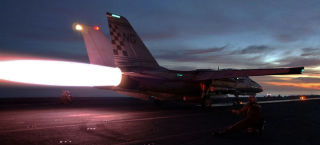I’ve only seen carrier flight operations from the perspective of my destroyer sailing behind it, acting as plane guard. This is a good overview of what is actually happening there.
LCDR Joe “Smokin” Ruzicka, the last F-14 Radar Intercept Officer to fly the Tomcat Tactical demonstration, is back to walk us through exactly what it took to strap on a 70k pound F-14 Tomcat in the dark of night and successfully get flung off the front of a US Navy super carrier via one of the ship’s mighty steam-piston catapults.
I walk closely behind Corky through the passageway, making sure I have all of my gear strapped down while there is still a fraction of light. Once you step outside the hatch to the flight deck, it’s likely the only real light will be a partial moon hidden behind some clouds. Corky told me to grab the back of his survival vest once we stepped out onto the flight deck and not to let go. The flight deck of an aircraft carrier is simply too dangerous for a new guy to wander around on, especially at night and alone.
Immediately after you step outside, your senses strain to help your brain figure out what is going on. Your eyes see nothing. It’s too dark. You better have your flashlight out and pointed at the ground or you will step on something dangerous. Your ears hear the high whine of other airplanes turning just above you. The first thing you smell is jet fuel. Lots of it. The fumes are everywhere, but it’s not suffocating, just omni-present. Mostly, you just feel the rush of wind interspersed with an intermittent burst of jet exhaust. The wind might be hot or it might be cold, depending on the time of year and the location of the ship, but the exhaust is always hot. In any case, the air is definitely moving and it creates a noise inside your helmet that can be partially deafening.
Source: How To Successfully Get Launched Off A Carrier At Night In A F-14 Tomcat
